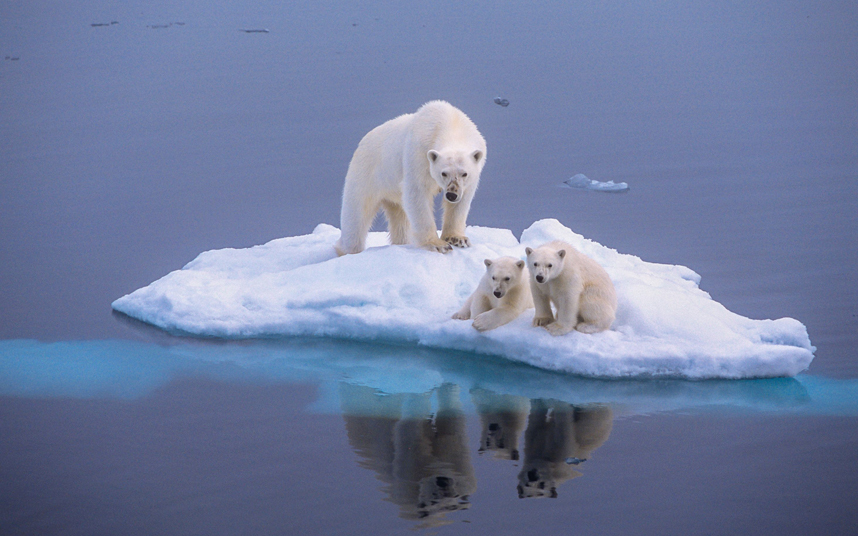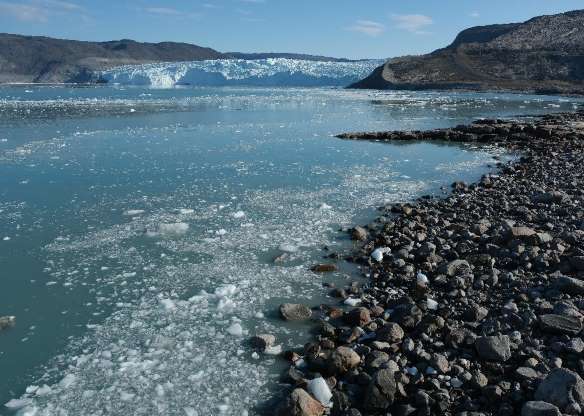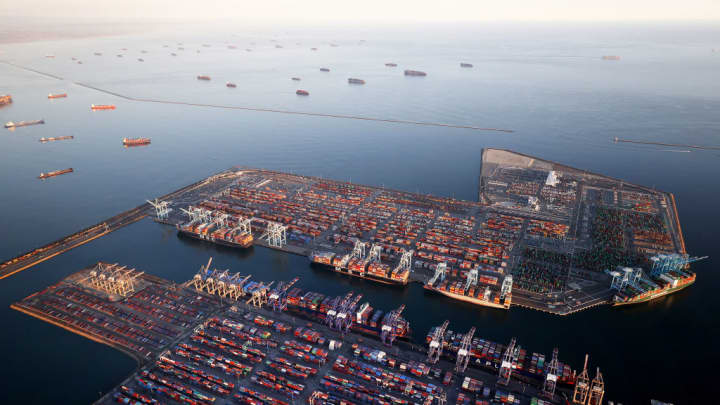Two years ago, I wrote a blog, “Cherry-Picking Data in an Energy Transition: Renewables & Polar Bears” (September 17, 2019) that took stock of where we stood in the ongoing energy transition. I am repeating the photos from that blog here, with two questions: What is the mama-bear trying to teach her cubs now? and what does the ice-water phase transition represent today?
For me and those of you with enough imagination, Figure 3—with its loaded ships full of imported containers stuck in the LA port, ties in with Figure 2. One is a literal freeze and the other a supply-chain freeze. It is difficult to teach your cubs in these kinds of transitions how to move forward.
I posted the 2019 blog only a few months before the COVID-19 pandemic struck the world. Climate change impacts were in a slightly earlier stage. With God’s help, and a great deal of work by vaccine innovators, many of us have been able to get vaccinated; surges and variations aside, predictions say that the COVID-19 pandemic is winding down. Meanwhile, the impacts of climate change are clearly getting worse. As I have often discussed, we are living through two immense phase transitions. One is existential and mostly irreversible, marked on a generational time scale. The other has claimed more than 5 million lives within a matter of months but is hopefully more temporary. Can we learn from one how to mitigate the other?
Phase transitions (like water to ice in Figure 2) are among the most complex physical systems that science encounters; the components of the two phases coexist and interact with each other in unique ways. We have made great progress in understanding these systems on a laboratory scale. We have a long way to go in understanding them on a global, human scale.
 Figure 1 – Mama-bear trying to teach her cubs what to do
Figure 1 – Mama-bear trying to teach her cubs what to do

Figure 2 – A freezing lake

Figure 3 – The supply-chain freeze in import arrivals at the Los Angeles port
The last few blogs focused on large fossil fuel companies that are finding themselves in the middle of a stuttering energy transition. Forced by external factors, many are starting to announce that they will go green by 2050, whether or not they want to.
Many of them have grudgingly promised to lower their own emissions while carefully avoiding any further commitments that might undercut profits:
Earlier this year, Chevron faced a reckoning when 61 percent of the company’s shareholders backed a nonbinding resolution asking it to cut its emissions. The oil and gas giant had previously announced goals to make its operations less carbon-intensive, but at its annual general meeting in May, shareholders effectively crossed their arms and shook their heads, demanding that the company cut emissions from the use of its products, too.
But even after the majority shareholder vote, Chevron is barely budging.
On Monday, Chevron announced a new “aspiration” to reduce emissions from its upstream operations to net-zero by 2050, along with a separate target of reducing the carbon intensity of its products by 5 percent by 2028. That mouthful of words means the company plans to keep producing just as much oil as it always has, if not more, but emit less carbon per barrel.
Activist shareholders were not impressed with the update.
Nor is Chevron the only company with this attitude: “US oil majors have largely favored plans that target the emissions produced by their own operations, covering just a tiny proportion of their wider impact on the climate.”
Even when cornered, these companies are trying to deny responsibility. Right now, we’re in a climate change-triggered phase transition: either we can keep using conventional fossil fuels, allowing energy companies to continue business as usual, or we can replace the fossil fuels with sustainable energy sources and other fuels such as nuclear energy that don’t leave the same level of destructive residues in the physical environment. However, in order to sustain the global economy, we still need access to current energy levels. Fortunately, we are making progress; renewable energy is poised to overtake fossil fuels in some places:
Australia’s clean energy transition is tipped to accelerate to the point that most homes will have solar panels paired with batteries by 2030 and the nation could have the highest penetration of renewable energy per-capita of anywhere in the world.
As pressure mounts ahead of the Glasgow climate summit for Australia and other developed nations to quit coal-fired electricity by 2030, a new report compiling the views of 30 energy industry and government leaders, including Federal Energy Minister Angus Taylor, details the commonly held expectation that the shift to clean power rolling through the sector is only going to get faster.
While that’s great news, we immediately see negative effects on a global scale if the requirement to replace conventional fossil fuel with non-carbon-emitting energy sources is not synchronized with energy production needs. Below are two examples from China and Europe:
China is dealing with rising energy demands as the pandemic begins to slow; the country’s response is not eco-friendly:
BEIJING — A bread company can’t get all the power it needs for its bakeries. A chemicals supplier for some of the world’s biggest paint producers announced production cuts. A port city changed electricity rationing rules for manufacturers four times in a single day.
China’s electricity shortage is rippling across factories and industries, testing the nation’s status as the world’s capital for reliable manufacturing. The shortage prompted the authorities to announce on Wednesday a national rush to mine and burn more coal, despite their previous pledges to curb emissions that cause climate change.
Mines that were closed without authorization have been ordered to reopen. Coal mines and coal-fired power plants that were shut for repairs are also to be reopened. Tax incentives are being drafted for coal-fired power plants. Regulators have ordered Chinese banks to provide plenty of loans to the coal sector. Local governments have been warned to be more cautious about limits on energy use that had been imposed partly in response to climate change concerns.
“We will make every effort to increase coal production and supply,” said Zhao Chenxin, the secretary general of the National Development and Reform Commission, China’s top economic planning agency, at a news briefing on Wednesday in Beijing.
Soaring natural gas prices have roiled Britain and the rest of Europe, leading to price spikes in the cost of electricity that are raising utility bills for consumers, putting pressure on energy suppliers and disrupting industries.
The consequences of the turmoil are unfolding every day, as factories shut down, ministers huddle with business leaders to find solutions and idled coal-burning plants are pressed into service to provide more power.
On Wednesday, the crisis became geopolitical as the U.S. energy secretary, Jennifer M. Granholm, appeared to take aim at Russia, the largest supplier of gas to Europe. The United States and its allies, she said, “have to be prepared to continue to stand up when there are players who may be manipulating supply in order to benefit themselves.”
There are suspicions that Moscow is using the gas markets to pressure Europe to sign off on a giant new pipeline to Germany called Nord Stream 2. For years, Nord Stream 2 has been a lightning rod in U.S.-Russian relations …
Globally, the transition is much worse in developing countries that don’t have the resources required for a successful energy transition. Since the impact of this transition is global, selective mitigation is not doing much good. In the same way that they need to ensure worldwide vaccine availability in order to effectively end the pandemic, rich countries must contribute to facilitating the energy transition in the developing world. Larry Fink, the chairman and CEO of the investment company Blackrock, described this situation forcefully:
As the leaders of the World Bank and the International Monetary Fund meet this week, they have a chance to reimagine how the world can use finance to reduce the risks from climate change.
For the economies working toward the goal of achieving by 2050 a net-zero world — one where we have removed as much of our carbon emissions as we produce — a huge obstacle will be mobilizing enough private investment to help developing countries do their part. In the coming decades, emissions from fast-growing emerging markets such as Brazil, India, Indonesia, and South Africa are expected to increase at faster rates than those from rich countries like the United States, the members of the European Union and Japan. If this comes to pass, the entire world will be overwhelmed by the effects of climate change.
Achieving the net-zero transition will require unprecedented levels of investment in technology and infrastructure. Investments in low-carbon projects in poor countries will need to total more than $1 trillion a year — more than six times the current rate of investment of $150 billion.
The next two blogs will try to address two key issues in this complicated transition: where should we aim our changes? and how long do we really have to transition before the planet becomes irreversibly unlivable? November is coming up soon; when the COP26 international meeting takes place in Glasgow, Scotland, the world will announce its collective commitments to the transition. I’ll be watching.
